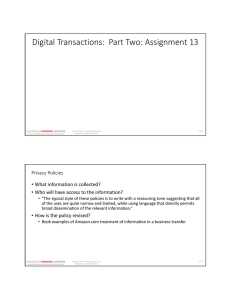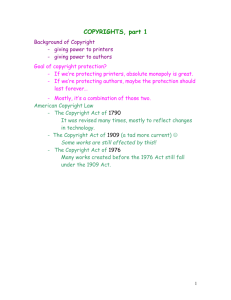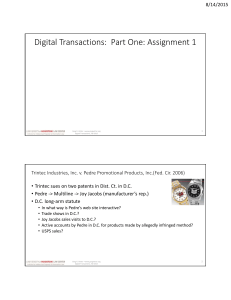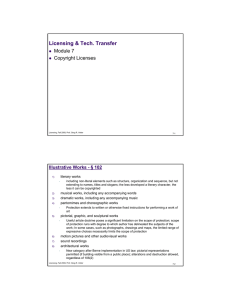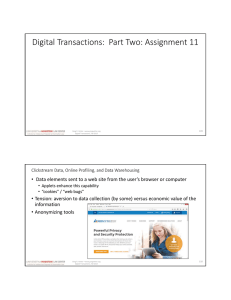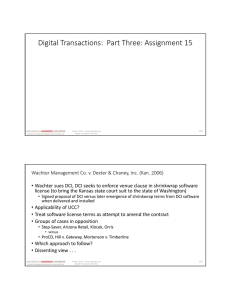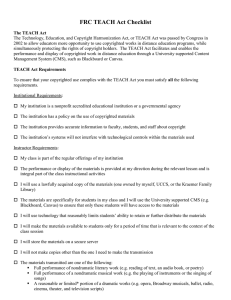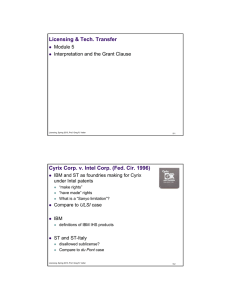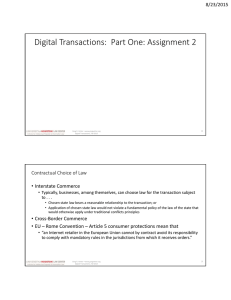Digital Transactions: Part Two: Assignment 5 Development Agreements
advertisement
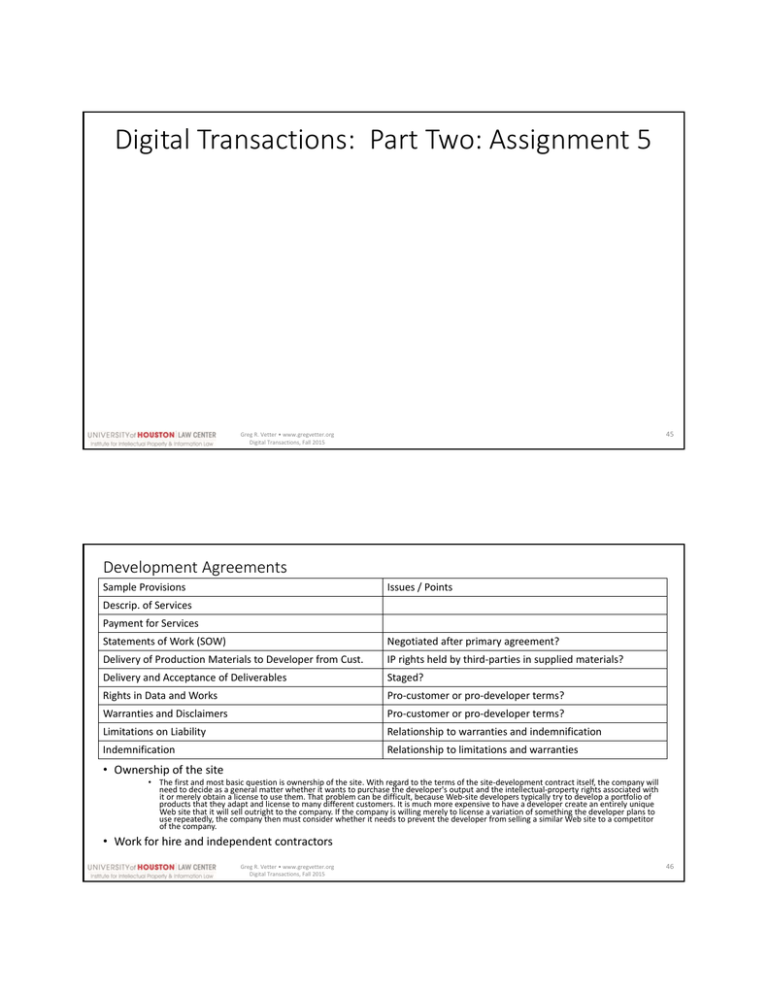
Digital Transactions: Part Two: Assignment 5 45 Greg R. Vetter • www.gregvetter.org Digital Transactions, Fall 2015 Development Agreements Sample Provisions Issues / Points Descrip. of Services Payment for Services Statements of Work (SOW) Negotiated after primary agreement? Delivery of Production Materials to Developer from Cust. IP rights held by third‐parties in supplied materials? Delivery and Acceptance of Deliverables Staged? Rights in Data and Works Pro‐customer or pro‐developer terms? Warranties and Disclaimers Pro‐customer or pro‐developer terms? Limitations on Liability Relationship to warranties and indemnification Indemnification Relationship to limitations and warranties • Ownership of the site • The first and most basic question is ownership of the site. With regard to the terms of the site‐development contract itself, the company will need to decide as a general matter whether it wants to purchase the developer's output and the intellectual‐property rights associated with it or merely obtain a license to use them. That problem can be difficult, because Web‐site developers typically try to develop a portfolio of products that they adapt and license to many different customers. It is much more expensive to have a developer create an entirely unique Web site that it will sell outright to the company. If the company is willing merely to license a variation of something the developer plans to use repeatedly, the company then must consider whether it needs to prevent the developer from selling a similar Web site to a competitor of the company. • Work for hire and independent contractors Greg R. Vetter • www.gregvetter.org Digital Transactions, Fall 2015 46 Exclusive Rights in © Works ‐ § 106 • Subject to sections 107 through 121, the owner of copyright under this title has the exclusive rights to do and to authorize any of the following: • (1) to reproduce the copyrighted work in copies or phonorecords [material object in which sound is fixated . . .]; • (2) to prepare derivative works based upon the copyrighted work; • (3) to distribute copies or phonorecords of the copyrighted work to the public by sale or other transfer of ownership, or by rental, lease, or lending; • (4) in the case of literary, musical, dramatic, and choreographic works, pantomimes, and motion pictures and other audiovisual works, to perform the copyrighted work publicly; • (5) in the case of literary, musical, dramatic, and choreographic works, pantomimes, and pictorial, graphic, or sculptural works, including the individual images of a motion picture or other audiovisual work, to display the copyrighted work publicly; and • (6) in the case of sound recordings, to perform the copyrighted work publicly by means of a digital audio transmission Greg R. Vetter • www.gregvetter.org Digital Transactions, Fall 2015 47 Illustrative Works ‐ § 102 literary works 1) • including non-literal elements such as structure, organization and sequence, but not extending to names, titles and slogans; the less developed a literary character, the less it can be copyrighted musical works, including any accompanying words dramatic works, including any accompanying music pantomimes and choreographic works 2) 3) 4) • Protection extends to written or otherwise fixed instructions for performing a work of art pictorial, graphic, and sculptural works 5) • Useful article doctrine poses a significant limitation on the scope of protection; scope of protection runs with degree to which author has delineated the subjects of the work; In some cases, such as photographs, drawings and maps, the limited range of expressive choices necessarily limits the scope of protection motion pictures and other audiovisual works sound recordings architectural works 6) 7) 8) • New category after Berne implementation in US law; pictorial representations permitted (if building visible from a public place); alterations and destruction allowed, regardless of 106(2) Greg R. Vetter • www.gregvetter.org Digital Transactions, Fall 2015 48 Works for Hire • § 101 ‐ A ''work made for hire'' is – • (1) a work prepared by an employee within the scope of his or her employment; or • (2) a work specially ordered or commissioned for use as a contribution to a collective work, as a part of a motion picture or other audiovisual work, as a translation, as a supplementary work, as a compilation, as an instructional text, as a test, as answer material for a test, or as an atlas, • if the parties expressly agree in a written instrument signed by them that the work shall be considered a work made for hire. • For the purpose of the foregoing sentence, a ''supplementary work'' is a work prepared for publication as a secondary adjunct to a work by another author for the purpose of introducing, concluding, illustrating, explaining, revising, commenting upon, or assisting in the use of the other work, such as forewords, afterwords, pictorial illustrations, maps, charts, tables, editorial notes, musical arrangements, answer material for tests, bibliographies, appendixes, and indexes, and • an ''instructional text'' is a literary, pictorial, or graphic work prepared for publication and with the purpose of use in systematic instructional activities. • works prepared by employees AND within the scope of employment (and also § 201(b) requirement that work be prepared FOR the employer) Greg R. Vetter • www.gregvetter.org Digital Transactions, Fall 2015 49 Conwell v. Gray Loon Outdoor Marketing Group, (Ind. 2009) • Conwell’s company (“Piece of America” (POA)) uses Gray Loon for website design and hosting • First Version, about $8,500 • Revision, about $5,200 more – but not paid, as a result, Gray Loon stopped hosting (First Version files removed and not retained) • Gray Loon suit for non‐payment, POA suit for conversion • Issues • Applicable law? (“predominate thrust” of goods or services?) • Contract requiring payment for Revision? (enforceable without price term?) • Conversion by Gray Loon of First Version of site? (copyright analysis, and licensing analysis) Greg R. Vetter • www.gregvetter.org Digital Transactions, Fall 2015 50 Assignment Five Problems • 5.1 to 5.3 • 5.4 & 5.5 Greg R. Vetter • www.gregvetter.org Digital Transactions, Fall 2015 51
